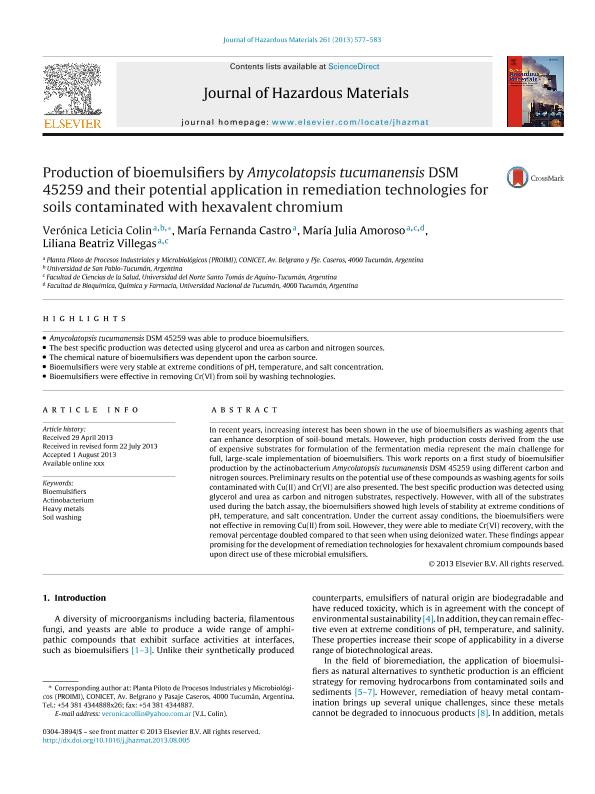Mostrar el registro sencillo del ítem
dc.contributor.author
Colin, Veronica Leticia

dc.contributor.author
Castro, María Fernanda
dc.contributor.author
Amoroso, Maria Julia del R.

dc.contributor.author
Villegas, Liliana Beatriz

dc.date.available
2016-05-20T20:24:54Z
dc.date.issued
2013-09
dc.identifier.citation
Colin, Veronica Leticia; Castro, María Fernanda; Amoroso, Maria Julia del R.; Villegas, Liliana Beatriz; Production of bioemulsifiers by Amycolatopsis tucumanensis DSM45259 and their potential application in remediation technologies forsoils contaminated with hexavalent chromium; Elsevier; Journal of Hazardous Materials; 261; 9-2013; 577-583
dc.identifier.issn
0304-3894
dc.identifier.uri
http://hdl.handle.net/11336/5755
dc.description.abstract
In recent years, increasing interest has been shown in the use of bioemulsifiers as washing agents thatcan enhance desorption of soil-bound metals. However, high production costs derived from the useof expensive substrates for formulation of the fermentation media represent the main challenge forfull, large-scale implementation of bioemulsifiers. This work reports on a first study of bioemulsifierproduction by the actinobacterium Amycolatopsis tucumanensis DSM 45259 using different carbon andnitrogen sources. Preliminary results on the potential use of these compounds as washing agents for soilscontaminated with Cu(II) and Cr(VI) are also presented. The best specific production was detected usingglycerol and urea as carbon and nitrogen substrates, respectively. However, with all of the substratesused during the batch assay, the bioemulsifiers showed high levels of stability at extreme conditions ofpH, temperature, and salt concentration. Under the current assay conditions, the bioemulsifiers werenot effective in removing Cu(II) from soil. However, they were able to mediate Cr(VI) recovery, with theremoval percentage doubled compared to that seen when using deionized water. These findings appearpromising for the development of remediation technologies for hexavalent chromium compounds basedupon direct use of these microbial emulsifiers.
dc.format
application/pdf
dc.language.iso
eng
dc.publisher
Elsevier

dc.rights
info:eu-repo/semantics/openAccess
dc.rights.uri
https://creativecommons.org/licenses/by-nc-nd/2.5/ar/
dc.subject
Bioemulsifiers
dc.subject
Actinobacterium
dc.subject
Heavy Metals
dc.subject
Soil Washing
dc.subject.classification
Bioremediación, Diagnóstico Biotecnológico en Gestión Medioambiental

dc.subject.classification
Biotecnología del Medio Ambiente

dc.subject.classification
INGENIERÍAS Y TECNOLOGÍAS

dc.title
Production of bioemulsifiers by Amycolatopsis tucumanensis DSM45259 and their potential application in remediation technologies forsoils contaminated with hexavalent chromium
dc.type
info:eu-repo/semantics/article
dc.type
info:ar-repo/semantics/artículo
dc.type
info:eu-repo/semantics/publishedVersion
dc.date.updated
2016-02-05T15:01:16Z
dc.journal.volume
261
dc.journal.pagination
577-583
dc.journal.pais
Países Bajos

dc.journal.ciudad
Amsterdam
dc.description.fil
Fil: Colin, Veronica Leticia. Consejo Nacional de Investigaciones Científicas y Técnicas. Centro Científico Tecnológico Tucumán. Planta Piloto de Procesos Industriales Microbiológicos (i); Argentina
dc.description.fil
Fil: Castro, María Fernanda. Consejo Nacional de Investigaciones Científicas y Técnicas. Centro Científico Tecnológico Tucumán. Planta Piloto de Procesos Industriales Microbiológicos (i); Argentina. Universidad San Pablo Tucumán; Argentina
dc.description.fil
Fil: Amoroso, Maria Julia del R.. Consejo Nacional de Investigaciones Científicas y Técnicas. Centro Científico Tecnológico Tucumán. Planta Piloto de Procesos Industriales Microbiológicos (i); Argentina. Universidad del Norte Santo Tomás de Aquino; Argentina. Universidad Nacional de Tucumán. Facultad de Bioquímica, Química y Farmacia; Argentina
dc.description.fil
Fil: Villegas, Liliana Beatriz. Consejo Nacional de Investigaciones Científicas y Técnicas. Centro Científico Tecnológico Tucumán. Planta Piloto de Procesos Industriales Microbiológicos (i); Argentina. Universidad del Norte Santo Tomás de Aquino; Argentina. Consejo Nacional de Investigaciones Científicas y Técnicas. Centro Científico Tecnológico San Luis. Instituto de Química de San Luis; Argentina
dc.journal.title
Journal of Hazardous Materials

dc.relation.alternativeid
info:eu-repo/semantics/altIdentifier/url/http://www.sciencedirect.com/science/article/pii/S030438941300561X
dc.relation.alternativeid
info:eu-repo/semantics/altIdentifier/doi/http://dx.doi.org/10.1016/j.jhazmat.2013.08.005
dc.relation.alternativeid
info:eu-repo/semantics/altIdentifier/doi/10.1016/j.jhazmat.2013.08.005
Archivos asociados
